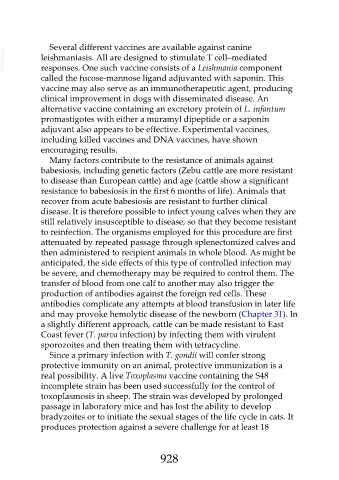Page 928 - Veterinary Immunology, 10th Edition
P. 928
Several different vaccines are available against canine
VetBooks.ir leishmaniasis. All are designed to stimulate T cell–mediated
responses. One such vaccine consists of a Leishmania component
called the fucose-mannose ligand adjuvanted with saponin. This
vaccine may also serve as an immunotherapeutic agent, producing
clinical improvement in dogs with disseminated disease. An
alternative vaccine containing an excretory protein of L. infantum
promastigotes with either a muramyl dipeptide or a saponin
adjuvant also appears to be effective. Experimental vaccines,
including killed vaccines and DNA vaccines, have shown
encouraging results.
Many factors contribute to the resistance of animals against
babesiosis, including genetic factors (Zebu cattle are more resistant
to disease than European cattle) and age (cattle show a significant
resistance to babesiosis in the first 6 months of life). Animals that
recover from acute babesiosis are resistant to further clinical
disease. It is therefore possible to infect young calves when they are
still relatively insusceptible to disease, so that they become resistant
to reinfection. The organisms employed for this procedure are first
attenuated by repeated passage through splenectomized calves and
then administered to recipient animals in whole blood. As might be
anticipated, the side effects of this type of controlled infection may
be severe, and chemotherapy may be required to control them. The
transfer of blood from one calf to another may also trigger the
production of antibodies against the foreign red cells. These
antibodies complicate any attempts at blood transfusion in later life
and may provoke hemolytic disease of the newborn (Chapter 31). In
a slightly different approach, cattle can be made resistant to East
Coast fever (T. parva infection) by infecting them with virulent
sporozoites and then treating them with tetracycline.
Since a primary infection with T. gondii will confer strong
protective immunity on an animal, protective immunization is a
real possibility. A live Toxoplasma vaccine containing the S48
incomplete strain has been used successfully for the control of
toxoplasmosis in sheep. The strain was developed by prolonged
passage in laboratory mice and has lost the ability to develop
bradyzoites or to initiate the sexual stages of the life cycle in cats. It
produces protection against a severe challenge for at least 18
928

